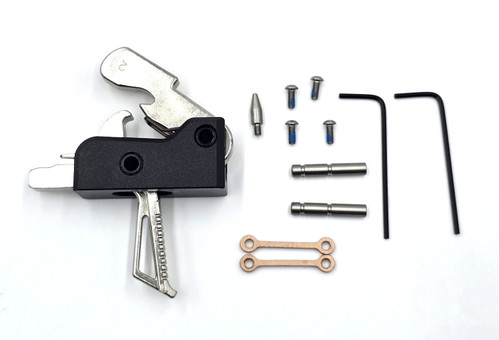AR-15 Lower Parts Kits: Questions and Answers
Aug 21st 2025
The AR-15 rifle is America’s Rifle, and one of the most popular platforms in the country, hands down.
Widely available, predominantly chambered in .223 and 5.56, both of which are popular cartridges, and extremely versatile, there are many, many reasons that the rifle is so common, and why it has spawned so many other similar modern sporting rifles.
With that said, instead of buying complete rifles, some home builders prefer to buy lowers and then an AR-15 lower parts kit, then pair these with assembled uppers.
It offers a fair degree of flexibility in how you customize the build, and is enjoyable to some people.
But it also brings up a lot of questions, some of the more common among which we are going to answer herein.
What Comes with an AR-15 Lower Parts Kit?
First, let’s cover what comes with an AR-15 lower parts kit.
Most importantly, let’s get this out of the way: an AR-15 lower parts kit typically does not come with a lower since that is considered a firearm by the ATF, is serialized, and requires an FFL transfer.
Rather, an AR-15 lower parts kit usually comes with all of the parts necessary to complete a finished lower receiver before mating it to an assembled upper.
Usually, a lower parts kit will contain:
- A trigger group, inclusive of the trigger, hammer, disconnector and associated springs (pictured below)
- A fire selector lever
- A bolt catch assembly (bolt catch, plunger, spring and roll pin)
- A mag catch assembly (catch, release button and spring)
- A pistol grip and hardware
- Pivot and takedown pins, spring and detents
- Buffer retainer and spring
As a general rule, if it is a complete AR-15 lower parts kit, it should contain all of the parts listed above.

Why Are There Two Receivers?
That’s just the way AR rifles are designed. Whereas most firearms have a single receiver (or in the case of handguns, a pistol frame) that accepts all of the other parts, including the barrel, stock, and trigger group, ARs have an upper receiver (which receives the barrel and bolt carrier group) and a lower receiver (which receives the trigger assembly and fire control unit.
Do I Need an FFL Transfer for an AR-15 Lower Parts Kit?
You do not need an FFL transfer for an AR-15 lower parts kit, though there might be other local laws or ordinances surrounding purchase, possession or transfer of firearm parts, so if you have further questions, consult a firearms lawyer in your area.
Do I Need an FFL Transfer for a Lower?
You do need an FFL transfer for a lower receiver, since that is the part of the gun that is considered the “firearm” and not just a part. Since the ATF regulates the lower as the gun itself, you will need an FFL transfer to get one if it is complete and can be used to assemble a functioning rifle.
What About for an Upper?
Whereas you do need an FFL transfer for an AR-15 lower receiver, you do not need one for an upper, also sometimes referred to as a stripped upper. This is because the upper is not considered the firearm itself, despite the fact that it is a firearm part without which you cannot complete assembly of an AR-15 style rifle.
What Comes with an Upper (or Upper Parts Kit)?
When you buy an assembled upper, it should be ready to pair with a completed lower receiver. Typically, an assembled upper will come with a stripped upper to which the barrel, handguard, and gas system (block and tube) are attached
If the barrel is threaded it will likely come with a muzzle device, which, most of the time, is a flash hider.
Assembled uppers also usually come with bolt carrier groups, although they don’t always come with them.
Often they also include ejection port covers (also called dust covers), forward assists, and charging handles, but not always, so read the included parts list carefully before buying.
What Is a Receiver Blank?
A receiver blank, also known as an 80% lower, 80 lower, or in political circles, pejoratively as a “ghost gun,” is an AR-15 lower receiver that has not been completely machined, and so cannot accept the fire control unit or trigger group. To be used in the assembly of a complete rifle, an 80% lower must be completed using a drill, drill press, router, and lower jig.
However, some states and other jurisdictions have outlawed receiver blanks. Always consult a firearms lawyer in your area before proceeding with a project that involves one.
Still Have Questions About AR-15 Lower Parts Kits?
Thinking you might want to go the route of customizing an AR-15 with a lower, an AR-15 lower parts kit, and an assembled upper? Check out our lower parts kits and if you have any questions about assembly, compatibility, or anything else associated with the project, get in touch with us directly.

